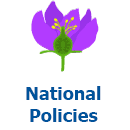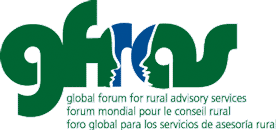 Every country has developed, formulated, and decreed national policies related to rural advisory services. Find some examples here. If you are looking for a national policy from a specific country, please use the search function, selecting the category “National policies” and the tag for the country.
Every country has developed, formulated, and decreed national policies related to rural advisory services. Find some examples here. If you are looking for a national policy from a specific country, please use the search function, selecting the category “National policies” and the tag for the country.
Taller Introductorio de la Integración de Género y Nutrición en Servicios de Extensión Agrícola
Written by Ingrid OliveiraUna Guía para el Facilitador
Esta guía del facilitador ha sido preparada para proveedores de servicio de extensión públicos, privados y ONG’s para así fortalecer sus capacidades para dirigir el tema de género en una manera transformadora e integrar la sensibilización del tema nutrición en el diseño y facilitación de talleres y capacitaciones dirigidos a agricultores y agricultoras. La guía es un modelo… un marco de referencia para que el facilitador lo adapte y modifique según su cultura y entorno agrícola, así como para que incremente la comprensión de la integración del género y la nutrición en los programas de extensión agrícola existente.
Introductory Workshop on Integrating Gender and Nutrition within Agricultural Extension Services - Facilitator's Guide
Written by Ingrid OliveiraThis facilitator’s guide has been prepared for public, private, and NGO extension providers to strengthen their capacity to address gender in a transformative manner and to integrate nutrition sensitivity in designing and facilitating workshops and trainings for men and women farmers. The guide is a template…a framework for facilitators to adapt and modify to their distinct cultural and agricultural settings as they increase their understanding of integrating gender and nutrition into existing agricultural extension programming.
Institutional Review and Planning Framework for Integrating Gender and Nutrition within Agricultural Extension Services - Workbook
Written by Ingrid OliveiraInstitutional Review and Planning Framework for Integrating Gender and Nutrition within Agricultural Extension Services
Written by Ingrid OliveiraThis handbook provides a framework to help leaders of agencies providing extension services to examine their organizational mission (and the results implied by it), to analyze if and how the strategy of extension services helps them to accomplish their mission, and to confront key operational challenges faced in providing quality services. It is written as a workshop guide with practical steps to engage in this analysis. Of particular importance is how organizations can more fully integratae nutrition- and gender-responsive programming in their routine outreach efforts.
Improving Nutrition with Agricultural Biodiversity
Written by Ingrid OliveiraWhile the positive relationship between biodiversity, dietary diversity and health seems clear but based on anecdotal evidence, there is a pressing need for this relationship to be confirmed based on empirical evidence. Solutions to addressing the growing challenge of global malnutrition depend on innovations in policy and practice. Historically, dietary interventions have focused primarily on protein and calories, later on minerals and vitamins, and most recently on functional and healthful properties of foods, such as anti-oxidants. In each of these cases, a focus on single components within foods has frequently neglected the foods themselves as they fit into a food system and socio-cultural context. One important component missing from many complementary strategies aimed at scaling up nutrition interventions is agricultural biodiversity, also called agrobiodiversity, which applies a food systems approach to intervention strategies.
Improving Nutrition Through Diversified Foods Production and Utilization
Written by Ingrid OliveiraThis course is designed to provide agriculture TVET students the knowledge skil and attitude to enable them apply basic principles of human nutrion, promote and assist diversified agricultural foods production and consumption, and work in collaboration to address maternal and child malnutrition. The course is based on the nutrition core competencies identified for mid-level agriculture students and the principles of nutrition sensitive agricultural interventions and multisectoral collaboration for nutrition.
Over the past years, the International Fund for Agricultural Development (IFAD) has been increasingly proactive in enabling smallholder farmers across the developing world to increase production and productivity, while concurrently enhancing their access to markets and integration into the value chains. However, experience shows that productivity and income increases do not automatically translate into improved nutritional status, especially among women, young people and children. Around three quarters of undernourished people live in rural areas of developing countries and are those producing most of the food. Addressing nutritional issues is, therefore, crucial to combating rural poverty, feeding the world in a sustainable manner and ensuring a healthier future for the younger generations. Integrated homestead food production (IHFP) is one of the most promising pro-poor strategies to address undernutrition and specific nutritional deficits such as micronutrient deficiencies (Box 1). In a number of programmes in rural areas of all the developing regions, homestead gardens have been providing access to nutritious fresh food to households with relatively limited economic and productive assets. More recently, smallholder fish-farming has also become an important source of animal protein for poor households in rural areas.
This manual is intended for use by food security, nutrition, and livelihood programmers and practitioners for improved household food production and income generation. It represents a compilation of techniques and lessons learned from homestead gardening programs successfully implemented through the Consortium for Southern Africa Food Emergency (C-SAFE) in Lesotho. Many of the techniques described have been developed over time in a variety of countries and programs, and have been adapted in semi-arid and mountain climates in the southern lowlands of Lesotho. The success of the methodology has prompted Catholic Relief Services (CRS), Caritas Lesotho, and other partners to apply homestead gardening activities in other programs, such as the Mountain Orphan and Vulnerable Children Empowerment (MOVE) project.
A Training Manual for Community Workers in Growing, Preparing and Processing Nutritious Food
In 2006, the Food and Agriculture Organization of the United Nations (FAO), in close collaboration with the Food and Nutrition Council (FNC), the Nutrition Unit in the Ministry of Health and Child Care and AGRITEX in the Ministry of Agriculture, Mechanisation and Irrigation Development, developed the Healthy Harvest training manual as a tool for training community-based extension workers in good nutrition, the growing, preparing and processing of nutritious food. The manual has been used, since its publication, to train hundreds of government and NGO extension workers.
Agriculture, Nutrition and Health Essentials for Non-specialist Development Professionals
Written by Ingrid OliveiraMost delegates at the 2020 Conference Leveraging Agriculture for Improved Nutrition and Health were expert or programmatically active in agriculture, nutrition, or health, but very few had specialist expertise that crossed sectoral boundaries. A major finding of the conference was that a key barrier to integration between agriculture, nutrition and health professionals was a lack of understanding of the sectors in which participants were not active, and lack of a common ‘language’ with which to debate. This brief report aims to outline basic concepts and definitions, tools and indicators, and common interventions used by each development sector, in order to provide a baseline level of knowledge and understanding on which to build dialogue and collaboration.
More...
Getting Started: Running a Junior Farmer Field and Life School
Written by Ingrid OliveiraIn response to the growing number of orphans and vulnerable children, the Gender, Equity and Rural Employment Division (ESW) of the Food and Agriculture Organization of the United Nations (FAO), in close collaboration with the World Food Programme (WFP), has supported the development and implementation of Junior Farmer Field and Life Schools (JFFLS) in various countries of East and Southern Africa over the past several years. In the process, information and training materials have been developed, and reports produced. This JFFLS Getting Started! manual is the culmination of experiences of many individuals, communities, and organizations in Kenya, Mozambique, Namibia, Swaziland, United Republic of Tanzania, Zambia, and Zimbabwe, and is the result of a significant commitment by numerous organizations and individuals over the past few years.
This Food and Nutrition Security Training Module has been prepared to guide training in which facilitators will help participants in Farmer Field Schools to learn more about nutrition. The training can be run by one or two facilitators who have knowledge and experience in training, using active participatory methods. The training is divided into five topics which can be covered on separate training days. The course
includes information on food security; following the guidelines for good nutrition using locally available nutritious foods; food needs of family members with special food needs (pregnant and lactating women, infants and children); and personal and environmental hygiene and food safety.
Food and Nutrition Handbook for Extension Workers
Written by Ingrid OliveiraThe handbook will help extension workers to:
- Apply the Essential Nutrition Actions (ENA) at household and the community levels.
- Appreciate the importance of agriculture in improving nutrition and the implications of malnutrition to agricultural productivity.
- Mainstream nutrition in their work plans and routine activities.
This handbook is written so that participating farmers and their families can equitably address food production and nutrition issues for good health. FFS participants are encouraged to share what they learn with farmers in their community, schools and other community groups so their whole community benefits. Persons working in extension support services such as Agricultural Extension Development Officers (AEDOs), Health Surveillance Assistants (HSAs), and other service areas (Community Development, Forestry, Environmental Health, Teacher Development Centres, schools, etc.) can use the handbook to support farming families to diversify food production and utilization for better nutrition.

